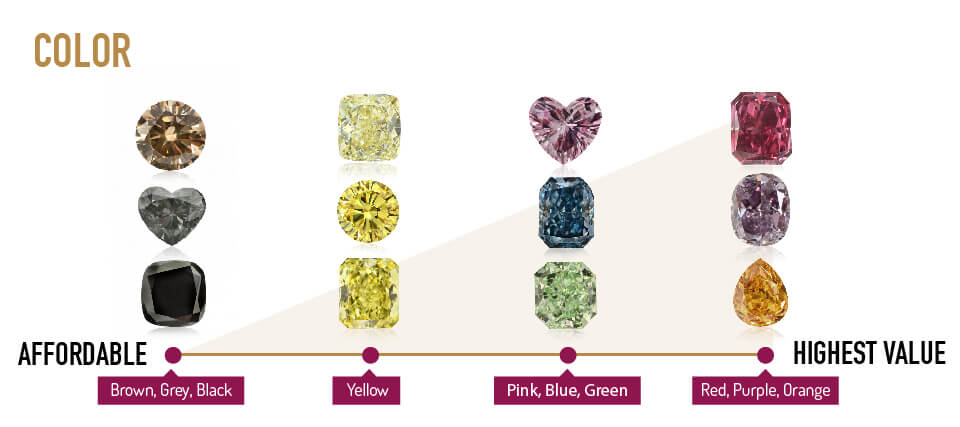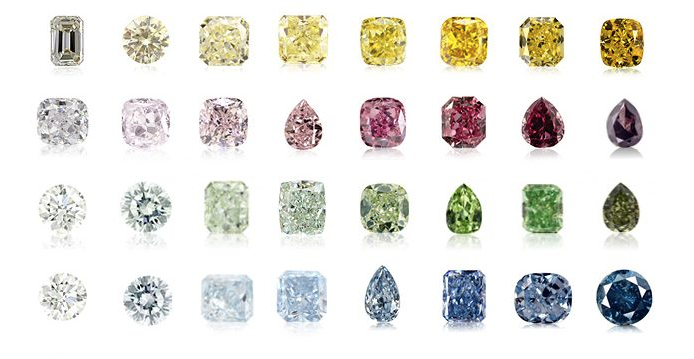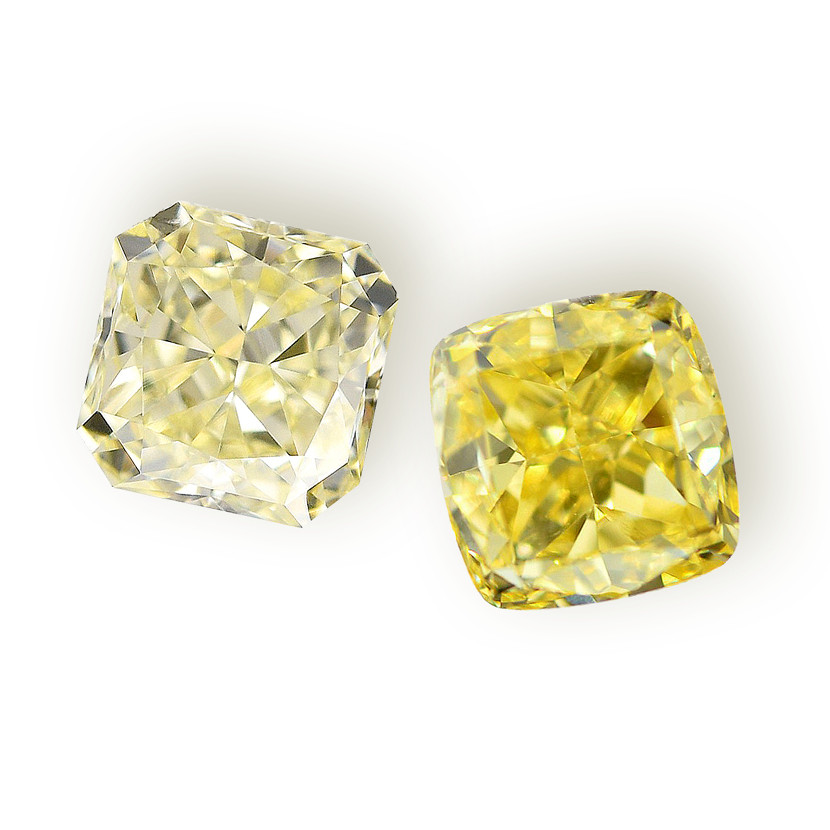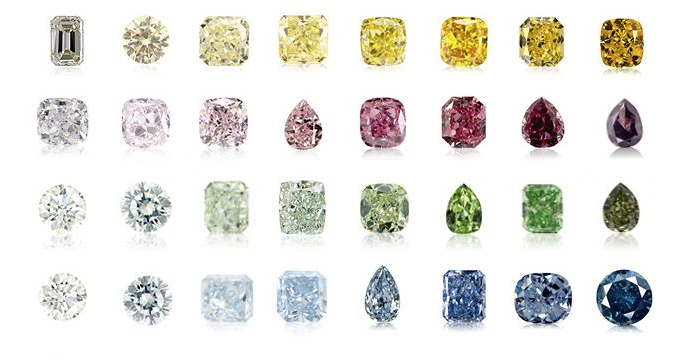To buy diamond jewellery, you need to consider several factors. To buy a diamond, you need to know the 4 C's: Cut, Carat, Clarity, and Color. An in-depth discussion of Diamond Color will be presented in this article. Our discussion will focus on Diamond Color, how it affects the value of a diamond, and the most common questions regarding Diamond Color!

Diamond Color - What Is It?
The colour of a diamond refers to its clarity or yellowness. Diamonds of the highest quality are generally colourless, while diamonds of lower quality often exhibit a faint yellow tint.
Gia's Color Scale, Which Ranges From D (Colourless) To Z (Light Yellow Or Brown), Is Used To Measure Diamond Colour. Diamonds range in colour from nearly colourless to slightly yellow between D and Z (the normal colour range).
You shouldn't overlook diamond colour when buying diamonds. It is one of the most critical aspects of the buying process. Colour can play a massive role in the price of diamond making. Picking the right colour for your specific needs can save you a lot of money without affecting the look of the ring.
In addition to blue, pink and yellow diamonds, there are also diamonds with distinctively coloured surfaces. It is generally not regarded as desirable for white diamonds to have a yellow tint.
The reason for this is that less natural light colour is reflected in the eye when slight colouring is present. As a diamond becomes more colourless, it becomes more radiant, valuable, and rare.
There is no denying that colourless diamonds are hard to find and rank much higher on the colour grading scale than diamonds with even a slight yellow tint.
A Diamond Color Scale's Importance
There is a limit to how much diamond colour matters. Cut, carat weight, and colour are separated from clarity and colour according to our approach to the 4Cs. To maximise value, cuts and carats should be maximised. When looking at a diamond, you want to avoid noticing negative characteristics such as colour and clarity.
Depending on the colour of a diamond, there is a line on the colour scale that indicates whether it is clear or yellowish. If you buy a diamond, you should avoid one with a yellowish tint so low that you notice it. Depending on the diamond's shape and setting style, the line between yellowish and clear varies.
It doesn't make much sense to spend more on higher colour if the diamond looks clear to you. Diamonds are a zero-sum game, so keep that in mind when buying one. To save money, you should avoid going with higher colour grades because you will lose out on size, brilliance, or clarity if you spend more money than necessary on colour grades.
Colour Scale of Diamonds: What You Need to Know
Here are a few things to consider before we get into the specifics of diamond colour.
Choosing a good diamond doesn't require you to be an expert in diamond colour. Listed below are some basic facts about diamond colour as well as our recommendations, which you can use to narrow down your search to diamonds of an acceptable colour based on your setting and shape preferences.
In addition, the differences between one colour grade and another (for example, a G colour diamond and an H colour diamond) are extremely small, so small that they're almost impossible to see.
When the diamonds are side by side, especially under bright light and with magnification, the difference between colours (for example, a G colour diamond and a K colour diamond) can often be seen easily.
It's not necessary to select the best colour grade when buying a diamond, as with everything else. When a well-cut G, H, or even I colour diamond is set in a ring and worn on your fiancé's finger, it will look just as good as a D colour diamond.
Lastly, which colour grade is best depends on the shape of the diamond and the metal used in its setting. A brilliant round cut, for example, hides colour well, while an emerald cut doesn't. It's therefore essential to choose a colour grade that matches the shape of the diamond.
Gold and rose gold, for example, can hide a diamond's faint yellow colour better than platinum or white gold when it comes to metals.
When shopping for a diamond, colour is just as important as cut, clarity, and carat weight. Colour must be balanced with the other three Cs when buying a diamond.
D-E-F Diamond Color (Colorless)
The colourless diamonds are D, E, and F, which means they are entirely colourless. D is a clear, icy colour without any yellow undertones. A D-grade stone has more body colour than an E-grade stone, so it is impossible to tell the difference without comparing it with a D-grade stone. The surface of F remains colourless, with just a little bit of colour visible when it is turned upside down.
Diamond Color - G-J (Near Colorless)
In diamonds, close to colourless diamonds (G, H, I, and J grades) provide the most value. Colours in the G category are just one step below the truly colourless tier, so they still appear pretty colourless. My opinion is that the H colour grade is the final colour grade where yellow or brown can be seen face up, so it makes a good "near-colourless" selection. A small amount of body colour appears on the upper surface of the skin. I colour easily masked in an excellent cut diamond, however. Yellow or rose gold settings are best with J colour, as it shows a bit more body colour than I.
Diamond Faint-Light Color K-Z
There is a significant amount of yellow or brown colour on the body of diamonds in grades K-Z. There is no such thing as a colourless stone in these ranges. A diamond's body colour becomes more intense as it gets closer to Z. Yellow gold diamonds set in K-Z colour can look like fancy yellow champagne diamonds (without the cost.) For a much more pale yellow diamond, couples should consider a K-M colour diamond. A diamond in the N-R range is recommended for a light-to-medium-toned yellow or brown diamond. In addition, you may want to look at S-Z colours if you want an intense colour.

An overview of GIA diamond colour
GIA uses diamond colour charts to grade diamonds based on their appearance and assigns each stone a colour grade within a given scale so that shoppers can understand each diamond's colour level.
It is recommended that you obtain a GIA certificate for every diamond you view when you are in the market for diamonds due to varying degrees of colour.
The Colour D
Almost no colour can be seen in D, the highest colour grade. The colourlessness of a D colour diamond will be apparent when viewed under magnification and by the naked eye. As yellow gold and other jewellery settings distract from the diamond's uncoloured beauty, D-color diamonds are usually set in platinum or white gold. With a significant price premium over other colour grades, diamonds with D colour grades are the rarest and most expensive on the market.
The Colour E
Diamonds of E colour resemble diamonds of D colour almost exactly. Under magnification, an expert gemologist can usually identify the differences between a D and E diamond's colour.
The Colour F
There is almost no visible colour in F colour diamonds, as opposed to D and E colour diamonds. Anyone other than an expert gemologist will be able to tell the difference between a D, E and F diamond even under magnification and side-by-side comparison.
The Colour G
The G colour diamond appears primarily colourless to the naked eye due to its lack of colour. According to the GIA's scale, the G colour grade is the highest and best in the "Near Colorless" range.
Even though G colour diamonds have a tinge of colour, their presence is almost impossible to notice with the naked eye. To reduce colour reflection from yellow or rose gold, these diamonds should be set in platinum or white gold.
The Colour H
Under magnification in bright lighting, H-color diamonds often show a faint yellow hue, especially when compared to diamonds of higher colour grades. In addition to platinum or white gold, these diamonds can be set in any metal without any problems. In comparison to diamonds in the colourless range, H colour diamonds are slightly more affordable than G colour diamonds. For diamond shapes with a large table, like radiants and cushion cuts, we recommend this colour grade.
The Colour I
A great combination of near-colourless looks and good value for money can be found in I colour diamonds. When compared with diamonds of a higher colour grade, these diamonds have a slight yellow tint.
The Colour J
A diamond of J colour appears colourless primarily to the naked eye, but under bright lights and magnification, it has a faint yellow tint. Under certain lighting conditions, the colour might also be visible in diamonds on a large table.
The Colour K
In the GIA's diamond colour scale, K colour diamonds are classified as "faint tint", which means they have a slight yellow tint that's visible even to the naked eye. This price range contains diamonds for significantly less than those from G to J. K colour round brilliant cut diamonds look gorgeous when they are set in a beautiful yellow gold setting. Platinum and white gold are generally not appropriate settings for diamonds of this colour grade.
The Colour L
In normal lighting conditions, L colour diamonds are visible with a yellow tint. There is a great deal of value for money in diamonds in this colour grade, which makes them more affordable than those in the G to J colour range.
The Colour M
The yellow tint in M colour diamonds can be seen with the naked eye. When compared to near colourless or colourless diamonds, M colour diamonds offer excellent value for money. Online diamond vendors usually offer the M colour grade as their lowest colour grade. The colour of M colour diamonds is quite noticeable even with the naked eye, even when set in antique yellow gold settings.
The Colour N-R
Yellow or brown tints are noticeable in diamonds in the N to R range. They are much more affordable than diamonds with faint tints or near colourlessness. A diamond-graded N-R is not recommended.
The Colour S-Z
Yellow or brown tints are easily noticeable in diamonds in the S-Z range. S-Z diamonds are not recommended due to this reason.
What Is The Process For Grading Diamond Colour By Gemologists?
To determine diamond colour, diamond experts use daylight-equivalent light and white backdrops without magnifying them. To determine the hue of a diamond, gemologists use Master Stones because people are unable to recall colour accurately. A Master Stone is a diamond that has already been colour graded by an independent laboratory. It ensures consistency and quality of diamond grading between gemologists when new diamonds are compared to Master Stones.
Conclusion
To find the perfect diamond, you must identify the elements that have the most significant influence on its beauty and brilliance.
It isn't the colour of a diamond that matters most in general. If you decide to use a diamond in a ring, you should first choose the shape that you want, then make sure the cut quality is the best, as this will determine how brilliant the diamond looks once it is set. Choose the right colour based on the information above.

FAQs
What is the best diamond clarity?
When shopping for diamonds, clarity is an essential factor to consider. The clarity of a diamond is determined by the number of flaws it contains. The better the diamond, the higher its clarity.
Natural diamonds and synthetic diamonds are two types of diamonds. Due to the longer production process and longer lifespan of natural diamonds, they are typically more expensive.
Diamonds are classified into three clarity levels: flawless, excellent, and sound. The levels of flawless, very good, and excellent are also applicable to synthetic diamonds, but with a lower number.
How much is the cheapest colour diamond?
The colour of the diamond is the most critical factor when purchasing one. Diamonds are priced based on their colour. Hue, saturation, and intensity determine the colour of a diamond.
White diamonds are the most expensive, while yellow diamonds are the cheapest.
What is the value of D colour diamonds?
What you want in your diamond will determine the answer to this question. The D-colour diamond may not be for you if you are looking for something that will last. With their sparkle and shine, D colour diamonds may be worth it to you if you're looking for something that will make your outfit look better and more expensive than it is.
Do pink diamonds cost more than white diamonds?
The carat weight, clarity, colour, and cut of a diamond determine its price. No, that's not the case. Pink diamonds cost less because they have more flaws than white diamonds, so they are not more expensive. White diamonds are more common than pink diamonds.







